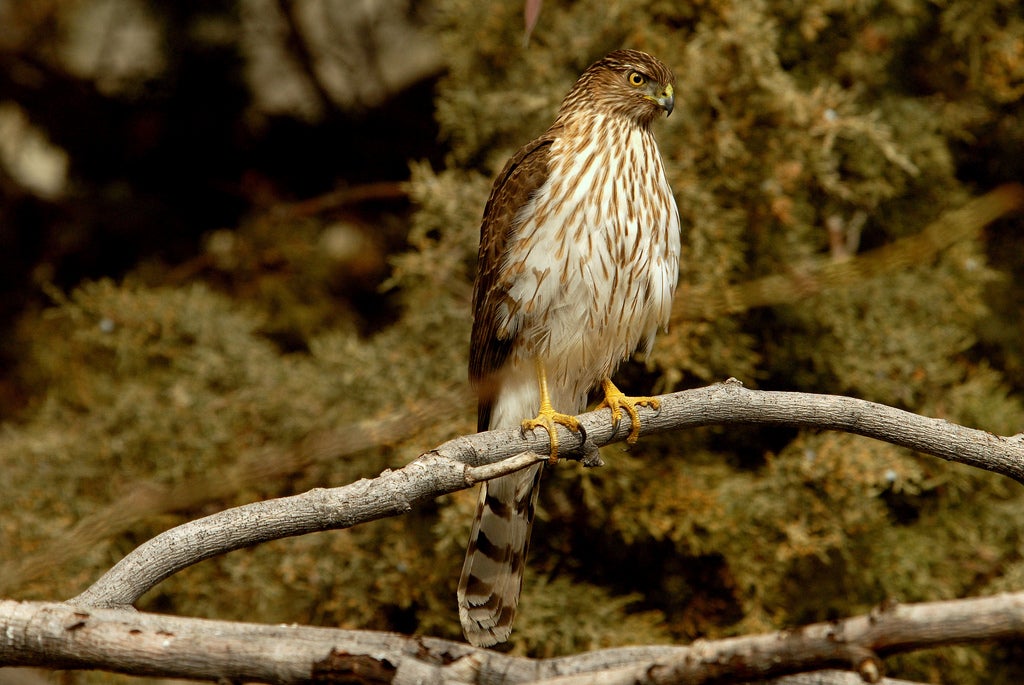SCIENTIFIC NAME:
Accipiter cooperii
OTHER NAMES:
Chicken hawk, blue darter, quail hawk
STATUS:
Breeder. Fairly common in fall in Gulf Coast region, uncommon in winter and spring, and rare in summer. In other regions, uncommon year-round. Low Conservation Concern.
DESCRIPTION:
Cooper's hawks are medium-sized birds with long, lean bodies and short, rounded wings. They have a long rudder-like tail that is crossed by several dark bands with a distinct white band at the tip.
They belong to a group of hawks known as accipiters that hunt primarily below treetop level and subsist chiefly on small birds and mammals. Several rapid wing beats followed by a brief period of gliding give the Cooper's hawk an unusual flight pattern. The Cooper's hawk does exhibit an explosive acceleration and reckless abandon when pursuing its prey. This darting through the forest and understory in pursuit of small birds led to the nickname "blue darter."
The Cooper's hawk has a blue-grey back with a dark blackish crown and a lighter nape. The long barred tail is more noticeable in flight than the short, rounded wings. The eyes are yellow in juveniles turning to orange and finally to red in adults. The curved beak is black on the tip and bluish at the base. Legs and feet are yellow. Males tend to be smaller than females but are more brightly colored than females.
DISTRIBUTION:
Cooper's hawks are found throughout all of the eastern United States, most of the central plains, and along the West coast. They range from British Columbia, Ontario, and Nova Scotia, south to Florida and Costa Rica. Cooper's hawks winter north to southern New England, British Columbia, throughout the United States and Mexico.
HABITAT:
Cooper's hawks are found in a wide variety of habitats including deciduous, mixed, and coniferous forests. Open woodland habitats such as woodplots, riparian woodlands, and semi-arid woodlands of the southwest are also important habitats. Cooper's can be found not only in rural areas, but also in urban areas that have a large number of trees.
FEEDING HABITS:
Cooper's hawks are sit-and-wait predators that perch in concealed places and dash out quickly to capture prey. It grasps its prey with talons, usually killing prey on impact. A Cooper's hawk will also hold its prey under water until all movement has ceased. Cooper's feed mainly on small to medium-sized birds and mammals. Birds such as jays, robins, woodpeckers, starlings, blackbirds, and small owls are favorites. Rabbits, squirrels, chipmunks, and other rodents are also preferred foods. Cooper's eat reptiles, amphibians, fish, and insects such as grasshoppers, butterflies, and crickets.
As the nickname "chicken hawk" implies, domestic fowl, such as chicken and pigeons, are also included in the hawk's buffet.
LIFE HISTORY AND ECOLOGY:
Males try to attract females by soaring in broad circles over treetops. The tail is closed and the wings are held high above its back. Pairs of Cooper's hawks can be seen soaring on thermals together. Cooper's hawks are monogamous and many pairs mate for life. They breed once a year, as early as March, and have one brood per season. The male selects the nest site but the nest-building is done primarily by the female. Nests are located in a fork or on a limb next to the trunk of a tree.
The nest is usually constructed of sticks and twigs in the shape of a cup lined with pieces of bark and down. Many times the nest may be built on top of an old squirrel's nest. The female lays three to six bluish to greenish-white eggs. These eggs become stained soon after being in the nest. Hatching occurs after a 32-36 day incubation period provided primarily by the female. The male provides food for the female.
Young are tended to by both parents until they leave the nest at about 27-34 days after hatching. Parents continue to provide food for about eight weeks.
As with many other species of raptors, Cooper's hawk populations seemed to decline during the 1940s and 1950s as a result of widespread use of DDT and other pesticides. Recent studies seem to indicate that population levels have increased significantly and it is now a species of low conservation concern in Alabama.
REFERENCES:
Bull, John and John Farrand, Jr. 1977. The Audubon Society Field Guide to North American Birds. Alfred A Knopf, Inc. New York, N.Y.
AUTHOR:
Randy Liles, Wildlife Biologist, Division of Wildlife and Freshwater Fisheries






